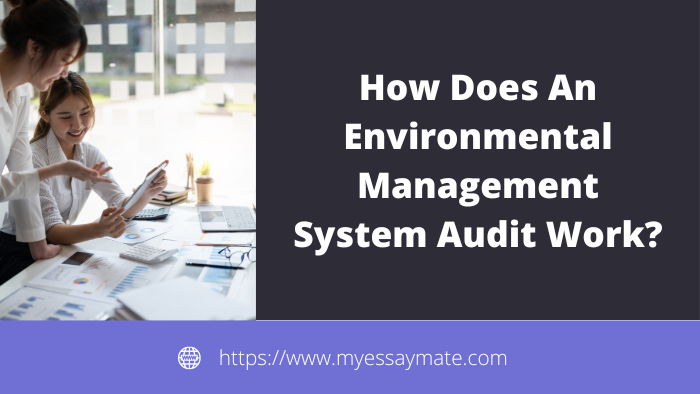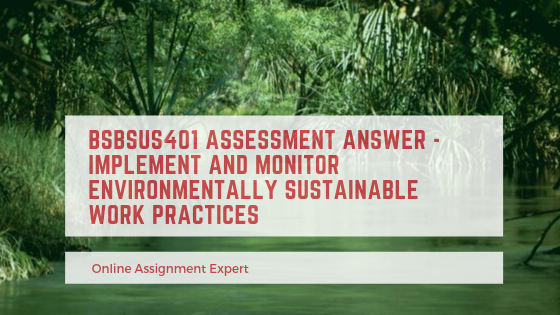
September 20, 2022
How Does An Environmental Management System Audit Work?
No 1 Assignment Help
is only a click away.
How Does An Environmental Management System Audit Work?
An environmental audit is a sort of examination used to find problems with protecting the environment and applying management systems, as well as the necessary corrective actions. They serve a similar (analogous) purpose to financial audits. To know "How Does an Environmental Management System Audit Work?" you must read the blog presented by our assignment help Australia.
EMS Auditing Benefits Go Beyond Regulation
Adherence to industry rules is one of the most fundamental advantages of a review and audit for EMS, but a great model with ongoing improvement can yield even more excellent outcomes.
The Environmental Management System Auditing Services guarantee a thorough examination of your EMS and provide conclusive results devoid of the fear and uncertainty frequently connected with audits. Learn how EMS auditing may save money, decrease regulatory risk, and enhance your company's environmental policy. Continue reading the post crafted by assignment help Australia professionals.
EMS Auditing for Today's Environment
The corporate policy places environmental protection at the centre. Regulators are examining, developing, and applying ecological regulations directly affecting a company's activities. Governments are also giving a new focus on environmental management as a result of increased regional and global pressure.
Stakeholders incredibly expect sustainable development, including investors, insurers, clients, and community members. A comprehensive audit of the environmental management system can assist the business in exceeding those goals.
To understand this topic in detail, feel free to avail assignment help Australia services.
The Role of an Environmental Audit in a Management System
Environmental management is becoming a necessity rather than a wonderful. It includes critical operational controls, compliance with regulations, and simply "being kind to the environment." Environmental rules and practices must be considered in any efficient management system, and integrating ecological management into economic strategy is essential.
Adherence with ISO 14001:2015, the environmental responsibility standard, is ensured by an EMS audit. A firm that has achieved ISO 14001:2015 accreditation treats environmental management very thoroughly.
The Benefits of an Environmental Management System Audit
Agreement with industry rules and the reassurance that procedures and goods consider their environmental damage is the most fundamental advantages of a review and audit for EMS. EMS audits not only raise a business's significant environmental efficiency and compliance but also offer:
- A method for utilising pollution-control techniques to accomplish EMS goals
- Best use of limited environmental resources
- Systematic and predictable control of environmental obligations
However, thorough environmental management system audits do more than just encourage environmentally friendly behaviour. A corporation can enhance operating efficiency and realise a variety of reductions for a proper competitive edge by completing a complete EMS audit. If a business is committed to ISO 14001:2015, EMS internal audits can highlight the company's focused efforts and hard work. In addition to EMS certification, a 14001 audit offers significant advantages like says the assignment help Australia experts:
Cost Savings
A thorough audit of an organisation's EMS can reduce costs and potentially open up new revenue opportunities through enhanced recycling. Additionally, a robust EMS lowers the generation and disposal expenses of trash. The following factors also contribute to cost savings:
- A decline in the usage and pricey disposal of explosive or potentially polluting products
- A reduced chance of fines for failing to comply with regulations
- Increased energy efficiency and decreased energy waste
By encouraging healthier consumption habits in aggregate and producing cost savings for regulation, safety, and financing, methodical EMS procedures could save money. For example, insurance firms might consider a licensed EMS when determining a company's costs.
Corporate Image
A strong EMS, backed up by an aggressive EMS audit, can boost goodwill and improve a company's reputation. A successful EMS can be the cornerstone of a marketing initiative, enhancing the company's reputation, and this may allow the business to enter new markets.
If an ecological problem occurs, further benefits might be attained. Regulators frequently prefer collaborating with businesses with a track record of dedication to environmental protection than those that operate carelessly.
Guidelines for Environmental Management System Auditing
The assignment help Australia professional says that the services are providing EMS audit tailor each EMS audit to the particular legal needs and environmental relations of that organisation. Right from the initial stage, they maintain open lines of communication with the staff at each organisation.
EMS auditing has a wide range of applications, including -
- Waste disposal
- Stormwater
- Drinking water
- Wastewater
- Air emissions
- Emergency response plans
EMS auditing may involve looking over papers and studying subjects like:
- Training requirements
- Position and charts descriptions of a firm
- Measures and strategies for corporate environment
- Internal and external communication plans
According to the assignment help Australia professionals, take every possible measure to ensure that the internal review of an environmental management system is simple to understand.
Different Stages of Environmental Audit
The assignment help Australia experts explain the five stages of an environmental audit.
Businesses should first examine data on the advantages and constraints of auditing before considering performing an audit or putting one in place. Academic journals, case analyses, or manuals that detail environment auditing programmes, different audit types, and the learnings from certain audits are some examples of a better understanding of the material.
Businesses may better comprehend the breadth of auditing with the help of this essential background knowledge, which also enables them to base their choices on their audit in an accurate way and illustrates how to best implement the knowledge they have gained into their operations.
Step 1: Confirm the Audit Dates
The EMR of a company sets the part of good care practice of audits according to the risk as the first step in the environmental audit process. Through discussions with pertinent government entities and/or examining the demands of particular projects, environment managers may decide how often the auditing should be conducted.
EMRs must synchronise the audit's timing to limit program activities' interruptions. Additionally, they must use the proper template from their EMS manual to include the audit information for each Environmental Management Plan (EMP).
Step 2: Prepare the audit
The EMR will create and record the Contractor to be inspected, the purpose and extent of the audit, and the details of the Region Contractors as the following stage in the environmental assessment.
If necessary, the EMR must additionally select and inform a qualified lead auditor. The EMR has the authority to name them as the Lead Auditor if necessary.
Step 3: Conduct the Audit
To review and examine the audit's breadth, the planned audit agenda, its goals, any project personnel who need to be interviewed, and a potential time for the exit meeting, the Audit Team should gather all necessary members.
Step 4: Develop an Audit Report/Action Plan
The environmental auditing firm must write a report depending on every factual data gathered throughout the audit.
Within two days after the audit's conclusion, this analysis must be sent to the Contractor. The Controller, Contractors, External Reviewer, Environment Auditor, the Government, and any other pertinent persons must get copies of the official report. More details can be acquired from our assignment help Australia experts that can help in developing an action plan.
Step 5: Follow-Up on Audit
The EMR will monitor the Firm's completion of any outstanding contract items. Based on how substantial the discovery is, it may be done independently or even at the time of the subsequent relevant audit.
For more information on environmental management auditing and how to write the concerned projects, visit us and get the best assignment help in Australia.
Related Blogs
Subscribe Our Newsletter & get Information about latest courses









